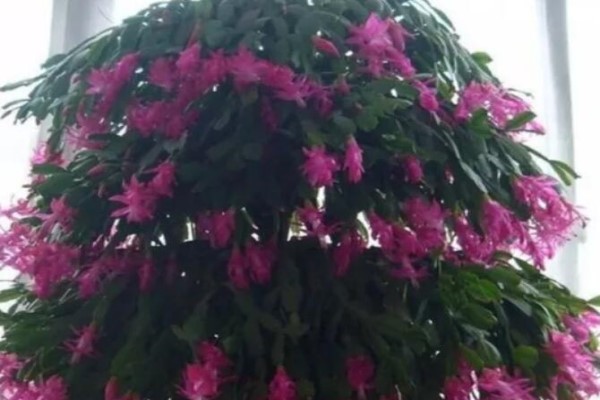Cut one knife in autumn, long-lived crab claw orchid. One tree blossomed in five colors and burst into a flower waterfall.

The crab claw orchid is grafted in this way and blossoms 100!
If you want the crab claw orchid to blossom more and more, you'd better choose grafting!
Procedure:
1. The rootstock of grafted crab claw orchid can choose cactus, leaf fairy and dragon fruit. But if the flower friends in the north are grafted with cactus, it is best to choose those varieties that are hardy, so that they will not freeze to death in winter.
2. Cut off the top stem segment of the cactus with a sterilized knife, then find a non-rusty nail, use the sterilized nail to pierce it down from the middle of the cactus incision, and remember to insert the whole nail into the cactus completely. Finally, just take the nail out!
3. Choose the scion needed for grafting, that is, the leaves of crab claw orchid. It is best to choose thicker and stronger leaves and retain 2-3 leaves, so as to improve the survival rate.
4. Use the sterilized blade to remove the left and right sides of the stem node at the lower end of the crab claw orchid leaf, leaving the part about the width of the nail.
5. Insert the treated branches of crab claw orchid directly into the interface pressed by the cactus with iron nails, and seal the interface with wax if you want the wound to heal faster. In this way, the grafting is successful!
6. after the grafting is completed, put the crab claw orchid in a cool and ventilated place to receive enough scattered light and do not water it in a hurry. About half a month later, if the crab claw orchid did not wilt, it was basically a successful grafting.
7. The interface of crab claw orchid grafted in this method is relatively small, the probability of bacterial infection is reduced, and the survival rate of grafting will be greatly increased. In the future, as long as good care, more fertilizer, will soon be able to make crab claw orchid bloom more!
Longevity flowers are so grafted that they are no longer black rot!
The longevity flowers at home are not raised well, and a large part of them are caused by black rot! So it is better to use Yushu to graft it, with Yushu grafting after the longevity, want to black rot is difficult!
Procedure:
1. Prepare the tools needed for grafting: sharp knives, alcohol and cling film, small clips.
2. Find a jade tree needed for grafting. Why is it grafted with jade trees? Because Yushu has thick leaves, evergreen all seasons, and is very drought-resistant, it is an ideal grafting rootstock for longevity flowers that are particularly prone to black rot.
3. First disinfect the knife with alcohol, then find a non-Lignified branch on the Yushu, cut off a section of the branch with the knife, then cut 2 knives in the middle, and cut the branch into a v-shaped incision.
4. Select the strong longevity flower branch, cut the lower end of the longevity flower branch into a duck beak, and then insert it directly into the branch of Yushu.
In order to make the wound heal faster, wrap the interface in a plastic bag and gently clip it with a small clip.
6. put the grafted longevity flowers in a cool and ventilated place, during which there is no need to water at all. after about 15-20 days, it is observed that if the leaves of the longevity flowers do not wilt, they are basically grafted to survive!
- Prev

This kind of flower, with a pot at home, is fragrant when it blossoms and is most suitable for making cakes.
In autumn, Huahua pinched and calculated that it was the flowering season of sweet-scented osmanthus. Sweet-scented osmanthus is no stranger to everyone, right? when Huahua sees the palace drama, the masters all like to eat this sweet-scented osmanthus cake, so you know how popular this sweet-scented osmanthus cake is? In fact, even if not in ancient times, even now, sweet-scented osmanthus cake is very popular. Not to mention sweet-scented osmanthus, some people like sweet-scented osmanthus, do not have a potted sweet-scented osmanthus in their own home, this is true love ah!
- Next

In the next month, these eight kinds of flowers will live in the soil, and they can bloom in autumn and winter!
Now the weather, morning and evening cool, warm at noon, is the best time for cutting, autumn and winter flowering plants, what triangle plum, longevity, crab claw orchid. Can cut root branches into the soil, can soon take root, the survival rate is also high, Huahua will take you to operate again today!
Related
- What if the leaves of potted flowers turn yellow?
- Florescence Control of several Flowers
- Anti-freezing technology and post-freezing nursing technology of flowers
- What is the classification of flowers? What are the common methods of flower classification?
- Prevention and control of alkali and acid damage of flowers in courtyard
- Technology of Anti-freezing and restoring growth of Flower seedlings in greenhouse and greenhouse
- How does flower fertilization not hurt the root? Fertilization technology of flowers
- Key points of disinfection in flower greenhouse
- Several pesticides that are banned or used cautiously in flowers
- How to fertilize the flowers that watch the leaves?

